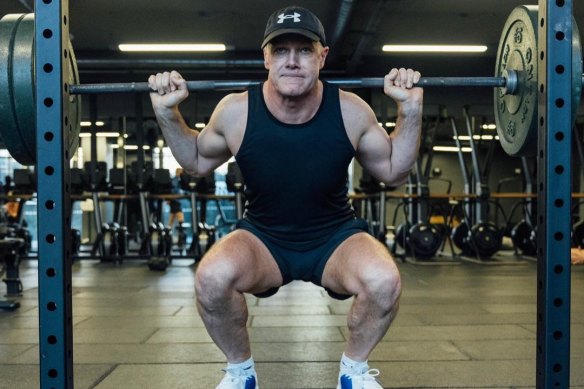Why everyone in finance is getting ripped
By Chris Bryant
Graham Ambrose has never felt stronger. He can barbell back squat 145 kilograms for four sets of six repetitions, and bench-press more than 100 kilograms for a single rep. His friends and colleagues notice that his clothes fit more tightly, and he’s fond of posting mirror selfies on Instagram.
But Ambrose isn’t a Gen-Z attention seeker: the 55-year-old is a managing director at Goldman Sachs Group. The London-based equity franchise sales specialist also has his own podcast, where he waxes lyrical about the benefits of picking up heavy things alongside his personal trainer, who calls him “G-dog”.

Graham Ambrose is photographed in a workout posted to his Instagram account.Credit:
A Goldman MD is not exactly a man of the people, but many readers will find Ambrose’s fitness experience more relatable than that of influencers in their 20s who don’t have as many work and family commitments. His message is one that finance workers absolutely need to hear, and it couldn’t come at a better time.
People who spend their working lives trying to manage risk in return for long-term financial gain often fail to apply those lessons to their own health. That’s partly because balancing personal wellbeing and professional success can be difficult in an industry that valourises long hours and now wants workers back in the office. But while finance hasn’t become a walk in the park, there is more awareness of the need to keep physically healthy and mentally resilient.
And strength training should appeal to bankers as the pay-off in terms of wellbeing – and ultimately longevity – can be profound.
The good news is Ambrose is increasingly preaching to the choir. When we Zoomed in January, he said clients and colleagues pepper him with questions about his routine and that “recently it’s been very difficult to find a free squat rack in the Goldman gym”.
Indeed, he isn’t the only Goldman weight-training evangelist. Jonny Fine, head of global investment-grade debt at Goldman, posts videos on Instagram of himself deadlifting at cult New York gym Dogpound, where an annual membership costs up to $US36,000 ($56,000). (Fine’s personal best barbell deadlift is 405lbs (184 kilograms) for one rep, he told me via email.)
American Psycho satirised bankers pumping iron for aesthetic reasons in the 1980s, but the reality was often an intense, high-stress and largely sedentary job whose long hours were punctuated by boozing and drug-taking.
Former Citigroup trader Gary Stevenson’s recent memoir The Trading Game describes the exhaustion, chest pains and depression that led him to quit the bank in 2014, aged 27. As recently as 2021, junior Goldman employees were still complaining about 100-hour work weeks, little sleep and deteriorating physical and mental health.
Nowadays, though, most banks have top-notch fitness facilities and some even provide workout clothes. It’s not uncommon for finance professionals to train with clients rather than go for a steak dinner.
‘You don’t need to ask permission to go to the gym because you’ll see your manager there too.’
Graham Ambrose, Goldman Sachs
“You don’t need to ask permission to go to the gym because you’ll see your manager there too,” says Ambrose. “It’s a real genuine change in the way people are interacting across the [Wall] Street. It’s also incredibly unifying: the boss could be learning to squat while a first-year analyst is squatting 160 kilograms.”
The tone at the top has improved too. Goldman boss David Solomon talks about his early morning exercise habit, while Morgan Stanley’s executive chairman, James Gorman, admitted last year to struggling with nausea-inducing stress early in his career that he defeated by getting much fitter.
Kim Fournais, CEO of Denmark’s Saxo Bank, is a fan of weightlifting and Krav Maga (a notoriously intense self-defence method), while the boss of Deutsche Bank’s investment arm DWS Group, Stefan Hoops, carries around a chest expander and hits the weight room most mornings. (His one-rep max bench press was 140 kilograms when a German finance podcast inquired last year.)
Of course, finance types aren’t the only ones to have caught the gym bug. A big chest and washboard abs have become as essential as owning a yacht for Hollywood actors and tech billionaires such as Jeff Bezos and Mark Zuckerberg. But this isn’t only a pastime of the super-rich, nor is it just a guy thing.
A decade ago it was rare to see women doing strength training. This was partly due to a misperception that doing cardio was the best way to lose weight – in fact, having more muscle increases metabolic activity, meaning you burn more calories throughout the day.
There were also unfounded worries that lifting weights would make women bulky. But encouraged by inclusive strength-focused workouts such as CrossFit, aspirational imagery on social media and a wealth of advice accessible online, the ratio of women to men in the weights area of most gyms is now closer to 50-50. Fitness centres have responded by removing treadmills and elliptical machines and devoting more space for barbells and weighted sleds.
“There are definitely more women at the gym getting stronger, which is amazing to see,” says London-based equity research analyst Eleonora Dani, 38, who got started in 2015 after reading a Bloomberg Businessweek profile of a female Goldman banker who did CrossFit.
“It seeded the idea that you can be a woman, be in finance and be strong,” she tells me by phone, requesting her employer not be identified. After losing 20 kilograms and gaining four kilograms of muscle in one year via a combination of personal training and Hyrox (a mix of cardio and strength training), Dani can now deadlift 105 kilograms for five repetitions.

Meta chief Mark Zuckerberg has posted about his fitness prowess to Instagram.Credit:
If you think about the different aspects of weight training, it makes sense that Wall Street types would want to get strong. It helps that sessions can be relatively short: unlike training for a marathon, a 45-minute strength workout is plenty. Building muscle also requires increasing the number of repetitions or weight each session, carefully planning meals and monitoring progress – something of a scientific approach that appeals to those in data-driven jobs. And there’s a huge sense of personal accomplishment when you finally achieve a goal like deadlifting double your body weight.
Of course, people lift weights to look good and feel more confident, but the benefits go far beyond bulging biceps. For Mike Mayo, a banking research analyst at Wells Fargo, it was the ability to strengthen bones weakened by osteoporosis and combat age-related muscle wasting (sarcopenia) that sparked his change from running and cycling to powerlifting – a mix of deadlifts, squats and bench presses.
There are also underappreciated mental health and hormonal advantages. “Our finance clients typically have an imbalance of [stress hormone] cortisol due to the nature of their work. Having more muscle mass gives you more control over that stress response,” says Mark Bohannon, a director at Ultimate Performance, an international chain of personal training gyms. (Dani is a client.)
“Meditation can be hard for some finance types,” he adds. “But if you are squatting with 100 kilograms on your back, I guarantee you are not worrying about your next meeting. You’re thinking: I’ve got to stand up now or this bar will crush me.”
Naturally, some folks take things to extremes. Devotees of podcasters such as Andrew Huberman, a jacked Stanford professor and neuroscientist, embrace whatever methods might offer a mental or physical edge, such as peptides, saunas and cold plunges.
But there’s no need to gobble dozens of supplements to get stronger. The main benefits come from doing the basics right: lifting weights three or four times a week, getting sufficient sleep and eating the right foods. That obviously requires planning, especially as banks demand staff back in the office and corporate travel picks up (hotel gyms don’t typically offer much in terms of weights).
“Nobody just finds the time to work out – it has always been something I intentionally schedule just like any other meeting,” says Randy Giveans, a former Jefferies Financial Group research analyst who now has an investor relations and business development role at Navigator Holdings. The 39-year-old father of three meets clients or investors for workouts at least a couple of times a month. “You can talk business between sets and it’s also a fun shared experience.”
But making the time is worth it. “This health movement in finance started partly due to increased productivity. People thought: I could stay up longer, I could read better and I could be more alert! But then they noticed they were also getting on better with their families and kids and becoming better people,” says Jason H. Karp, a former hedge fund manager turned entrepreneur. (This point about emotional wellbeing is echoed in Peter Attia’s excellent book Outlive.)
Rather than dread my 6am workouts, weight training is something I now look forward to. It’s satisfying getting stronger in my 40s and defying the decline that otherwise comes with ageing. Once I’ve picked up a heavy barbell, whatever else the day throws at me doesn’t feel as hard. So I’m glad Ambrose and his peers are making weight training more popular – but it will take further encouragement from employers to help finance professionals live healthier lives. If I’ve learnt anything from picking up heavy objects, it’s that progress comes one increment at a time.
Bloomberg
Read more:
- Fitness influencers are giving up high intensity exercise. But why?
- Welcome to Top Gun: The Australian fighter pilot preparing CEOs for war
- It’s never too late to lift: Older people can still build muscle mass
The Business Briefing newsletter delivers major stories, exclusive coverage and expert opinion. Sign up to get it every weekday morning.